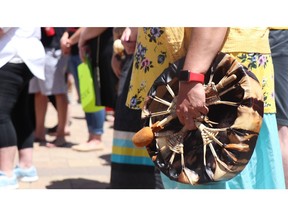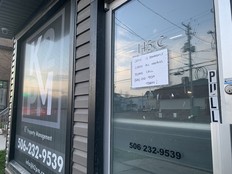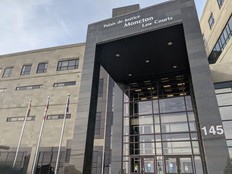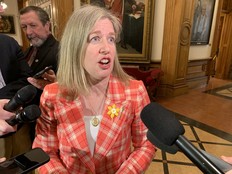Lawyers battle over whether Wolastoqey are meaningfully consulted
Court case brings out sharp differences on whether the province listens to Indigenous people on issues affecting their traditional territory

Article content
The provincial government and the Wolastoqey Nation battled in court Thursday as lawyers from both sides argued whether Indigenous communities were being properly consulted or given short shrift on big forestry decisions.
For four days, legal teams representing the province, Ottawa, Indigenous leaders and big timber companies have been presenting arguments before Justice Kathryn Gregory of the Court of King’s Bench.
She’s presiding over the Wolastoqey Nation’s big title claim for more than half of New Brunswick’s territory, on the western side, on what they consider their traditional lands.
The province has presented a motion to strike out a portion of their lawsuit, asking the judge to remove more than 250,000 land parcels owned by everyday New Brunswickers and private property held by several big timber firms named as defendants in the case.
The legal claim was launched in 2020 and is expected to take a decade or more to litigate, unless a settlement is reached first. It involves so many lawyers, the province rented a large conference room at the Fredericton Inn to run the court proceedings.
Most arguments presented over the four days referred to previous court cases, but one in particular raised tension on Thursday.
Josh McElman, the lawyer representing the province, brought up Haida Gwaii, previously known as the Queen Charlotte Islands, off of the western coast.
They want a Haida-like arrangement that’s already here.
Josh McElman
Twenty years ago, the Supreme Court of Canada said the provincial government of British Columbia had a strong obligation to meaningfully consult with the Haida Nation about logging on the archipelago. That ruling has served as a template for provincial governments across Canada on the duty to consult Indigenous people on big resource projects that impact their traditional territory.
Since then, B.C. and the Haida had been girding for a legal battle over Aboriginal title – an accepted legal concept in Canada which conveys a bundle of communal property rights to an Indigenous society. But last week, the two sides suddenly announced a settlement that will recognize both the Haida’s Aboriginal title and private property owners’ fee simple rights.
McElman used that case to pivot from his argument that New Brunswick had already been consulting meaningfully on issues of importance to the Wolastoqey.
He said he took issue with a theme that the Wolastoqey had promoted during the court proceedings – that the province was avoiding its constitutional responsibility to Indigenous people.
The lawyer pointed out that before the New Brunswick forestry strategy was released last year, the provincial government had spent 11 months consulting First Nations.
It also established a roundtable on forestry between the minister of natural resources and Indigenous chiefs to talk about wood harvesting and preservation areas, among other topics.
McElman then brought up the proposed Sisson Mine, which saw the two sides negotiate an accommodation agreement in 2017 if the property 100 kilometres northwest of the capital were ever developed to extract tungsten and molybdenum rock.
The agreement includes a revenue-sharing formula, environmental monitoring, training and employment opportunities for Indigenous people and a future land swap as replacement property for the traditional territory they’d lose.
“They want a Haida-like arrangement that’s already here,” McElman said to the judge. “There is no live controversy on this.”
There was muttering from one of three Wolastoqey chiefs sitting in the public gallery, as both the forestry strategy and the Sisson mine have caused upset in their communities.
When Mike Holland, the natural resources minister, announced the strategy, the chiefs dumped on it, and shortly after the Sisson Mine accommodation agreement was signed, several Indigenous protesters, including a group of grandmothers, set up an encampment on the proposed industrial site.
Let’s just bring down the temperature. This is very complex.
Kathryn Gregory
Renée Pelletier, lead counsel for the Wolastoqey, immediately took issue, standing up and raising an objection.
“My clients would have a lot to say about this,” she said, pointing to the public gallery. “This is not like Haida at all.”
The judge questioned McElman.
“No live issue?” she said. “There’s clearly disagreement between the parties.”
But after McElman had resumed, Pelletier continued making objections, arguing the government’s side was trying to present new evidence and she should have another opportunity to respond.
“Let’s just bring down the temperature,” the judge said. “This is very complex. If there’s something burning that you must bring up, we can deal with it.”
Once McElman wrapped up his arguments, and Pelletier had stated all her objections, the judge threw out a surprise question.
A big issue at stake is whether everyday private property owners whose land is part of the claim would be affected by a declaration of Aboriginal title. The Wolastoqey say no, but the defendants say yes.
The judge asked the lawyers whether she should appoint an amicus curiae – an impartial adviser to the court – to help represent “strangers to the claim,” all the private property owners who are unnamed in the court action. There are close to 500,000 people who live in the disputed territory, many of whom own homes and businesses and have no legal representation in the proceedings.
“I know no one has raised it,” the judge said. “But it’s been raised in other cases.”
Gregory said she would accept legal briefs from the lawyers, asking them to keep their arguments on whether it was a good idea or not brief, a maximum of 10 pages each.
The case resumes Tuesday, with motions presented by the timber companies.












Postmedia is committed to maintaining a lively but civil forum for discussion. Please keep comments relevant and respectful. Comments may take up to an hour to appear on the site. You will receive an email if there is a reply to your comment, an update to a thread you follow or if a user you follow comments. Visit our Community Guidelines for more information.